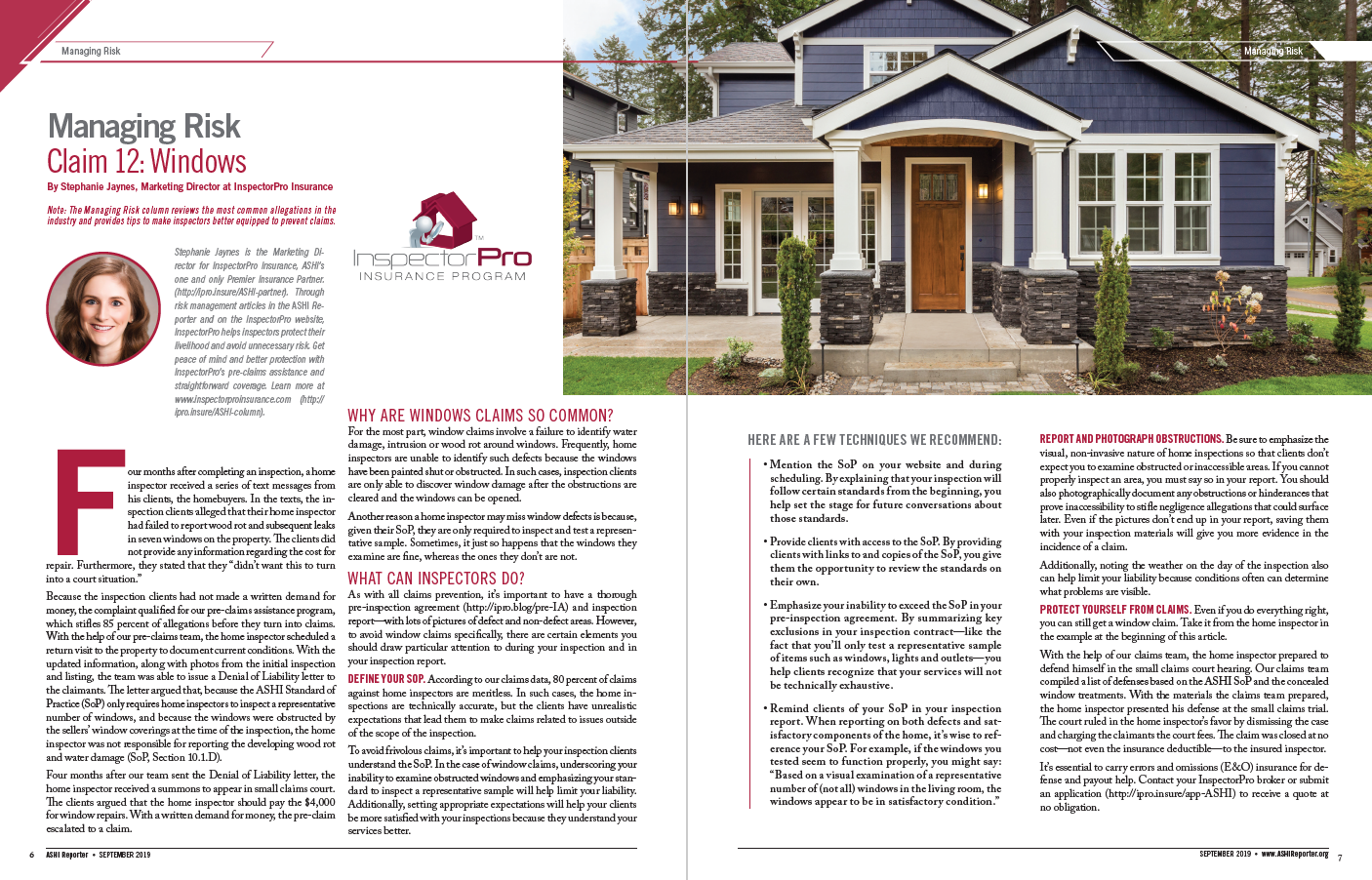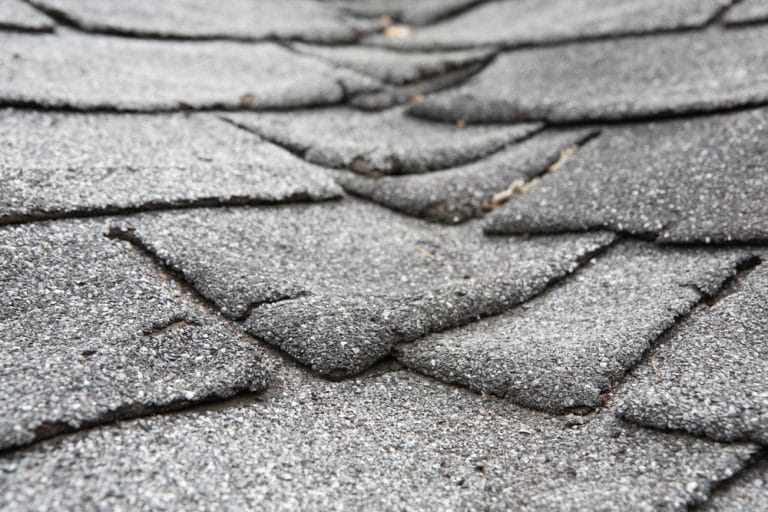Top E&O Claims Claim 12: Windows
Last Updated November 22, 2023

 Four months after completing an inspection, a home inspector received a series of text messages from his clients, the home buyers. In the texts, the inspection clients alleged that their home inspector had failed to report wood rot and subsequent leaks in seven windows on the property. The clients did not provide any information regarding the cost for repair. Furthermore, they stated that they “didn’t want this to turn into a court situation.”
Four months after completing an inspection, a home inspector received a series of text messages from his clients, the home buyers. In the texts, the inspection clients alleged that their home inspector had failed to report wood rot and subsequent leaks in seven windows on the property. The clients did not provide any information regarding the cost for repair. Furthermore, they stated that they “didn’t want this to turn into a court situation.”
Because the inspection clients had not made a written demand for money, the complaint qualified for our pre-claims assistance program, which stifles 85 percent of allegations before they turn into claims. With the help of our pre-claims team, the home inspector scheduled a return visit to the property to document current conditions. With the updated information, along with photos from the initial inspection and listing, the team was able to issue a Denial of Liability letter to the claimants. The letter argued that, because the ASHI Standard of Practice (SoP) only requires home inspectors to inspect a representative number of windows, and because the windows were obstructed by the sellers’ window coverings at the time of the inspection, the home inspector was not responsible for reporting the developing wood rot and water damage (SoP § 10.1(D)).
Four months after our team sent the Denial of Liability letter, the home inspector received a summons to appear in small claims court. The clients argued that the home inspector should pay the $4,000 for window repairs. With a written demand for money, the pre-claim escalated to a claim.
Why are windows claims so common?
For the most part, window claims involve a failure to identify water damage, intrusion, or wood rot around windows. Frequently, home inspectors are unable to identify such defects because the windows have been painted shut or obstructed. In such cases, inspection clients are only able to discover window damage after the obstructions are cleared and the windows can be opened.
Another reason a home inspector may miss window defects is because, given their SoP, they are only required to inspect and test a representative sample. Sometimes, it just so happens that the windows they examine are fine, whereas the ones they don’t are not.
What can inspectors do?
As with all claims prevention, it’s important to have a thorough pre-inspection agreement and inspection report—with lots of pictures of defect and non-defect areas. However, to avoid window claims specifically, there are certain risk management practices you can employ.
Define your SoP.
According to our claims data, 80 percent of claims against home inspectors are meritless. In such cases, the home inspections are technically accurate but the clients have unrealistic expectations that lead them to make claims related to issues outside of the scope of the inspection.
To avoid frivolous claims, it’s important to help your inspection clients understand the SoP. In the case of window claims, underscoring your inability to examine obstructed windows and emphasizing your standard to inspect a representative sample will help limit your liability. Additionally, setting appropriate expectations will help your clients be more satisfied with your inspections because they understand your services better.
Here are a few techniques we recommend:
- Mention the SoP on your website and during scheduling. By explaining that your inspection will follow certain standards from the beginning, you help set the stage for future conversations about those standards.
- Provide clients with access to the SoP. By providing links to and copies of the SoP, you give clients the opportunity to review the standards themselves.
- Emphasize your inability to exceed the SoP in your pre-inspection agreement. (For example, you’ll only test a representative sample of items such as windows, lights, and outlets.) By summarizing key exclusions in your inspection contract, you help clients recognize that your services will not be technically exhaustive.
- Remind clients of your SoP in your inspection report. When reporting on both defects and satisfactory components of the home, it’s wise to reference your SoP. For example, if the windows you tested seem to function properly, you might say: “Based on a visual examination of a representative number of (not all) windows in the living room, the windows appear to be in satisfactory condition.”
Report and photograph obstructions.
Emphasize the visual, non-invasive nature of home inspections so clients don’t expect you to examine obstructed or inaccessible areas. If you cannot properly inspect an area, you must say so in your report. You should also photographically document any obstructions or hindrances that prove inaccessibility to stifle negligence allegations that could surface later. Even if the pictures don’t end up in your report, saving them gives you more evidence for potential claims.
 Additionally, noting the weather on the day of the inspection also can help limit your liability. After all, weather conditions often can determine what problems are visible.
Additionally, noting the weather on the day of the inspection also can help limit your liability. After all, weather conditions often can determine what problems are visible.
Protect yourself from claims.
Even if you do everything right, you can still get a window claim. Take it from the home inspector in the example at the beginning of this article.
With the help of our claims team, the home inspector prepared to defend himself in the small claims court hearing. Our claims team compiled a list of defenses based on the ASHI SoP and the concealing window treatments. With the materials the claims team prepared, the home inspector presented his defense at the small claims trial. The court ruled in the home inspector’s favor by dismissing the case and charging the claimants the court fees. The claim closed at no cost—not even the insurance deductible—to the insured inspector.
It’s essential to carry errors and omissions (E&O) insurance for defense and payout help. Contact your InspectorPro broker or submit an application to receive a quote at no obligation.
Previously: Septic Claims.
This article was published in the ASHI Reporter in September 2019. See how this story appears in print below.






